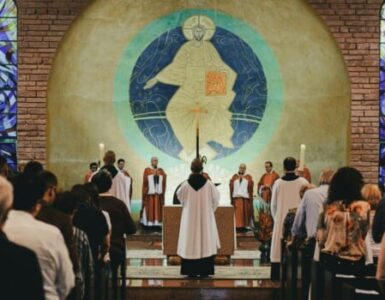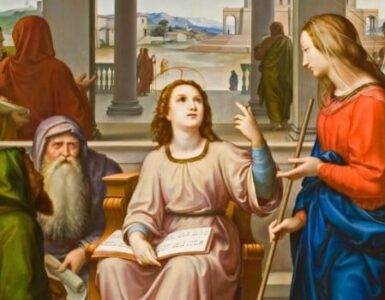Born close to the Mediterranean coast of Israel, Hebrew musician Elam Rotem has always found the musical language of Baroque Europe most natural. During highschool in Galilee, Rotem formed a vocal ensemble with some of his classmates. Now known as the “Profeti della Quinta”, Rotem’s quondam high school ensemble now performs Renaissance and Baroque internationally to great acclaim. More specifically, Rotem and his ensemble have premiered Rotem’s own ambitious baroque inspired compositions, defying the modern paradigm that all creative work must sound or look “new” to be a genuine expression of the artist.
Early Music Married to Even More Ancient Texts
Rotem is unique for setting biblical texts in their original Hebrew while utilizing the musical style of the early 17th century. Rotem’s most recent composition, a 2020 piece entitled The Lamentation of David, is a setting of 2 Samuel 1:17-27. Scored for five voices, a consort of violins and viols, and basso continuo accompaniment, The Lamentation of David utilizes intensely emotional word painting reminiscent of composers like Montiverdi and Caccini. Tempo changes and rhythm variations add spice to the piece as it covers the gamut of David’s sorrow.
Rotem’s Inspiration
Baroque composition in biblical Hebrew has a single precedent: the music of Salomone Rossi (ca. 1570 – 1630). An Italian Jewish violinist and composer, Rossi straddled the late Renaissance period and early Baroque in his transitional compositions. Among other more “standard” compositions, in 1623 Rossi published a work entitled “The Songs of Solomon” (the texts are non-Biblical religious texts, not to be confused with the biblical Song of Solomon or Canticle of Canticles). With little stylistic connection to the tradition of Synagogal music, Rossi’s Montiverdiesque music was not only the earliest published collection of Hebrew liturgical music, but represented an unprecedented innovation in synagogal music. “He also attempted to introduce Western/Christian musical traditions into the Synagogue.,” Rotem said in a 2018 interview.
Unsurprisingly, Rossi’s music captured the attention of the Profeti della Quinta, resulting in their recording two albums of his music and participating in a 2012 documentary The Search for Salomone Rossi. Rotem told the America-Israel Cultural Foundation that “being Israelis and native Hebrew speakers gave Profeti della Quinta the opportunity to specialize in the music of Salomone Rossi, the Jewish late Renaissance composer. This is thanks to our double specialization, both in early music and in the Hebrew language.”
Rotem’s first composition to follow in Rossi’s footsteps was his 2014 Rappresentatione di Giuseppe e i suoi Fratelli (Joseph and his Brethren), a musical drama in three acts similar to early operas or oratorios. Replete with narrative recitatives, arias, choruses, and instrumental interludes, Rotem’s music masterfully sets the dramatic tale of fraternal betrayal (watch the trailer). As Markus Schramek wrote, “The singers and instrumentalists were telling the biblical story of Joseph in a soul-stirring manner (it can hardly be described less bombastically). The pull of the composition is tremendous; after only a few bars the listeners were completely immersed in the performance. The director Rotem gently weaved the threads of the plot on the harpsichord. One rarely experiences such a fascinating Bible reading.”
Dark Biblical Love Tales
The most varied collection of Rotem’s compositions can be found in his album Quia Amore Langueo: Song of Songs and Dark Biblical Love Tales. Culling texts from the Song of Songs, as well as the tale of Sampson and Delilah and the story of Amnon’s incestuous rape of Tamar, Rotem draws upon the extensive Baroque tradition of depressing or risqué love songs.
In scale, the compositions of Quia Amore Langueo range from delicate lute songs like “I am the Rose of Sharon” to compositions for five and more parts like “Come With me From Lebanon”. The album also includes delicious instrumentals like this 3-part sinfonia, where Rotem stretches the vocabulary of baroque suspension to sparkling breaking point. Rotem said that he had “much pleasure working with the original texts in all their untranslatable beauty. Composing biblical Hebrew in stille rappresentativo is quite different from the motet style of Rossi, so I had to find my own way of doing so.” When most Italian baroque music was setting either Latin or Italian, Rotem had to contend with very different accentual pattern than those of the Romance languages: “The accents of the words in Hebrew are typically on the last syllable, which proved to be quite a challenge when trying to make the text flow in a recitar cantando manner.” Artistic constraints like these are, according to Rotem (in the 2018 interview), essential to all art.
Reasons for New Creation Through the Old
All artists of stature apprentice themselves to a tradition in order to develop their abilities. We see this in all the fine arts, including painting, music, architecture, and literature and poetry. Writers do not invent new languages every time they write a novel; poets are still writing in various forms many centuries after the form—like the sonnet—was invented; composers continue to write sonatas, marches, or entire symphonies; musicians continue to play violins and other instruments with hundreds of years of history; painters continue to use mediums like oil and watercolor to execute portraits and landscapes; architects creatively borrow both decorative ideas and structural principles from the ancient Greeks to their contemporaries. Not only does the creativity of artists operates within limitations of medium: their endeavors must allow dialogue between tradition and innovation.
Elam Rotem is an inspiring example of an artist utterly comfortable creating new work in an ancient idiom. As an avid devotee and performer of baroque music myself, Rotem’s music sounds to my ears not only utterly idiomatic but also truly creative: the music of this composer and of no other. It is not a rehash or a slavish imitation, but a new voice speaking new things with the beauty of an inherited language. It seems like a perfect answer to the question: ought and can anyone create using “old” styles? Of course they can—look at Elam Rotem’s compositions. And of course they should—just take some time to luxuriate in the luscious harmonies created by this marriage of old and new.













